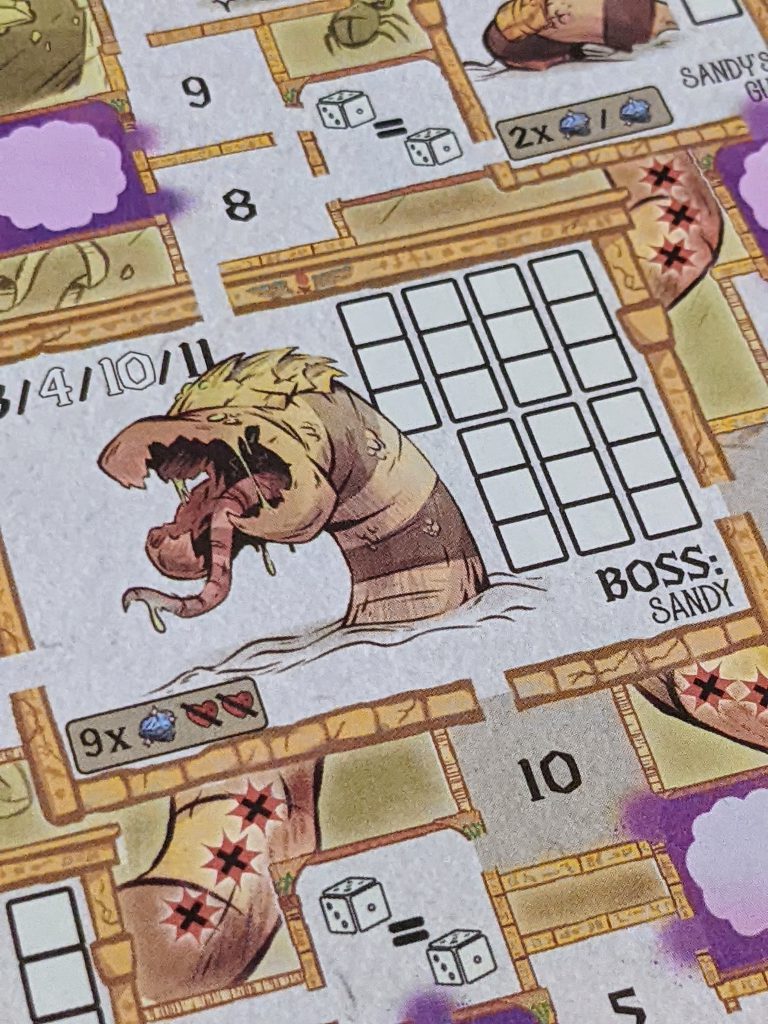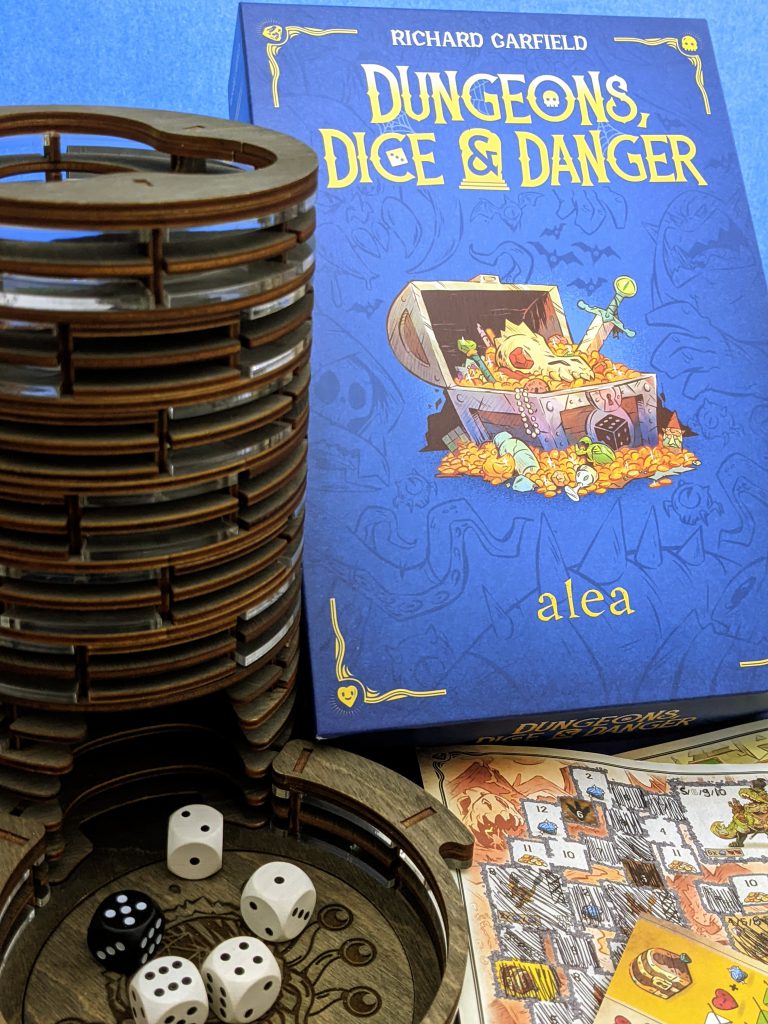Once upon a time, board game critic Dan Thurot tweeted and lightly admonished a sliver of the Board Game Discourse thusly: “Are board games Just Math? Sure. In exactly the same way that books are Just Words, movies are Just Frames, music is Just Notes, and video games are Just Pixels.”
Mr. Thurot was pushing back on those guilty of Just A Thing™ analysis. Incurious folk who reduce board games and their board game experiences to monosyllabic and abstract rubble by saying “It’s Just This” or “It’s Just That” – with no deeper curiosity, context, or even a human element. The Justies. To Justies, everything can be mashed into one-dimensional blurbs that say nothing about a game nor reveal anything about themselves (except maybe that they are total buzzkills you should disinvite to your next game night).
I thought of what Justies might say about Dungeons, Dice & Danger (published by alea). Upon first blush, their first draft/first thoughts would be to shrug the game off as Just Another Roll-and-Write, or Just Dice, or (worse) Just Math. But it would be dishonest. To diminish Dungeons, Dice & Danger this way does it dirty, and deprives them of a fun, playful roll-and-write and wistful dungeon crawl that reveals addictive, emergent frisson each time out. It’s a simple, quirky, terrific surprise.
D is for Dungeon: In DD&D, players choose a dungeon map to explore, grab pencils, and delve right in. Take a moment to look at your scoresheet before you start scribbling all over it. Because it’s gorgeous. The hand-drawn artwork by Cam Kendell is transcendent minutiae. It has the sweetness of Kyle Ferrin (the games Root and Fort), but also channels classic Disney fairy tales, Don Bluth’s Dragon’s Lair, and even Sergio Aragones’ anarchic marginalia from MAD Magazine and Groo the Wanderer.

The object in DD&D is to gain the most gems (aka points) through spelunking, hacking, and slashing through the dungeon; as with most roll-and-writes this is represented by rolling d6 dice (the Roll) and crossing out spaces and places on your map based on said dice rolls (the Write).
The game includes four different dungeon maps. Each map is replete with rooms, paths, gems, gold, treasure chests, traps, and other dangers. Every room has an assigned number value between 2-12 (aka all possible 2d6 dice rolls). Some rooms are empty, others aren’t. When dice results match a numbered room on your map, you cross it off. If there’s loot in it (gems or gold or treasure chests), you get that thing.
There are also monster rooms. Most dungeons have six unique monsters lurking within them. Monsters have multiple assigned dice values in their rooms (not just one). So more than one dice result damages them. Monsters also have hit points – 4 or 5 smaller boxes in their rooms that you must cross out to defeat them. Boss Monsters are tougher and have 12 hit points (boxes). You get gems for killing monsters; players who are “firsties” in defeating a specific monster get more.
[Also notable: while there is a bestiary of creatures and crawlies to vanquish, these dungeons are 100% without dragons. Which is probably prudent since for a game with the acronym DD&D the biggest foe isn’t so much Tiamat, but a Wizards of the Coast copyright lawsuit for skating too close to the Dungeons & Dragons trademark.]
D is for Dice: The goal is to cross out elements in your dungeon based on the dice rolled and shared by all players. Each turn 4d6 white dice and 1d6 black die are rolled together. Players must use all four white dice to create two discrete dice pairs, anyway they wish. The sums of each created pair (2-12) are the two numbered results you must cross off your dungeon map. (The black die is special; we’ll discuss that later).
Since this is a dungeon crawl and not bingo, you can’t (Just) cross off matching numbers from anywhere on your map. Rooms you explore and cross out must already be adjacent to previously explored, previously scratched-out rooms. Or it must be a dice result you can use to hit a monster (and only then if you are legally adjacent to that room already).
And this is where “D is for Danger” comes roaring in. Failure to cross off two numbers from your map each turn means you take hits for each unused result, or “miss,” which is tracked on your Life Tracker. Hits increase the negative points deducted from your score at game’s end. Hits also do damage (the reason it’s called the Life Tracker): take 10 hits in-game and you succumb to the dungeon. Player elimination IS possible in DD&D. (I can hear the Atari classic Gauntlet warning me: “your lifeforce is running out…”)
![]()
D is for Dice (Mitigation): The game can be cruel when the dice turn against you but there are ways to steer your fate. One involves the single black die that rolled with the four white dice each turn. Each turn there is an Active Player, which rotates from player to player around the table. Players normally make dice pairs with only the white dice each turn, but if you’re the Active Player you can also use the black die to make pairs and sums (so from a pool of five dice total). This increases your chances to find cross-outs on your map that avoid your taking damage.
Another baked-in mulligan are three Extra Black Dice spaces on your map sheet. Three times during the game you may use the (fifth) black die on your turn to make dice pairs – even if you aren’t the Active Player.
The final way to bend dice in your favor are with Treasure Chests. When you reach a room with a Treasure Chest, you choose from three different dice mitigation strategies. One is to get three more Extra Black Dice mulligans. One “heals” you by soaking up the next three hits that would have gone to your Life Tracker. And one grants you two Torches as free dice actions: you can automatically cross off an eligible room space (or do one hit of damage to an eligible monster) as if you rolled that result. You can even use both torches at once to cross off four spaces on your map as a Berserker-esque power move. There are only two Treasure Chests in the game so you may only get two of these three boons. Choose wisely.
The game ends when a player has defeated all monsters on their sheet. Final scoring is a bit like working out how to split the check at the tavern with your dungeon party. But generally speaking it’s total gems acquired and subtracting the points you took from the Life Tracker. There are also two shared goals unique to each dungeon that award gems based on specific set collections, with a bonus for being “firsties.” One map tasks you to “clear” six rooms full of rubble (which take two hits instead of one to access). Another features Sandy the Snake, with three of her segments (gut, spine, tail) as separate monsters on the map; you must race to be first to defeat the body parts trifecta.

Dungeons, Dice & Danger is one of the most interesting dice games and roll-and-writes I’ve ever played. It doesn’t do what one expects it should do as a roll-and-write or as a dice game (especially a dice game from the designer of King of Tokyo). It’s Sid Sackson-esque in its simplicty, and may seem unassuming upon first blush, but for me it contains wonders. Even though 2d6 is its currency, it doesn’t conform to the traditional notions of 2d6 probability as strategy. Having a Can’t Stop know-how will only help you to a point. And then probably derail you. Because DD&D is not Can’t Stop. It’s more like Don’t Starve. Because the dice rolls are resources. 2d6 numbers are what keep you alive and if you run out too soon you’ll die.
You always want to leave yourself with as many possible different dice results as possible on your map so you have maximum choice and minimum futility. Spaces with 6-7-8-9 values are valuable since they’re more likely to surface – but the distribution plot on the map isn’t equal for each dice value so there’s forced scarcity, and these popular numbers are the first to become extinct. So you hold out as long as you can to keep them in reserve on your map. 2’s and 12’s are generally on the fringes of the dungeon and contain gems, so you can’t sleep on rarer numbers or your score suffers. Maps have multiple pathways to get you somewhere but also have single-file pinch points and bottlenecks, which can be dastardly if you get a run of cursed dice, do not have a diversity of numbers stashed for a rainy day, and are out of mulligans.
There’s also the peculiar pacing. Blitzing through the dungeon and crossing everything out as fast as possible isn’t the best strategy if you aren’t grabbing those gems around the edges. And if you stall mid-game due to dice fails and impassable rooms, you fall behind losing many “firsties” gem contests with creature kills. Even if you don’t deal the final blow to the Boss, you want to do as much damage as you can to it to keep up with the leader. You also can’t sleep on those shared goals either, which usually aren’t connected to monster kills but to traveling over every inch of the dungeon.
Games of Dungeons, Dice & Danger possess a strange rhythm. There’s a subtle and invisible force you must harness that’s not dumb luck (Just Luck) but learned skill, like slowly achieving prowess with the blade. First games feel like rushing towards an opponent who uses your own momentum and body weight against you as he throws you to the ground. But then you get back up, and soon you understand this game state better and the headspace you have to inhabit to thrive in it, and start to remember the distinct personalities of each map. Then games are more thrilling and adventurous even when they are at their most agonizing with cursed dice syndrome.

I suspect that superficial Justies will hate this game. Because it doesn’t reward the one-play-and-done treatment. Just one play and you miss the gems glittering in the walls and floors of these dungeons. Just one play and you may trigger a lethal trap of your own creation. DD&D, reduced to Just Dice, woefully mischaracterizes its rich 3D-ness.
Dungeons, Dice & Danger isn’t Just Dice. It’s dice that propels a wonderful and immersive game experience, in a way that is just.


